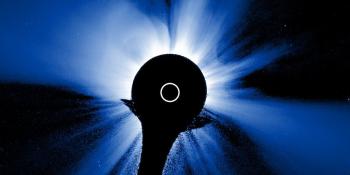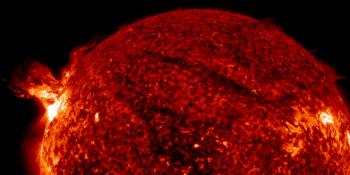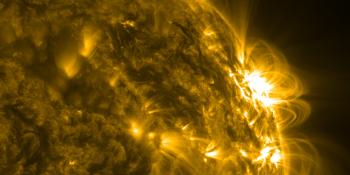Viewing archive of Thursday, 1 August 2002
Solar activity report
Any mentioned solar flare in this report has a scaling factor applied by the Space Weather Prediction Center (SWPC). Because of the SWPC scaling factor, solar flares are reported as 42% smaller than for the science quality data. The scaling factor has been removed from our archived solar flare data to reflect the true physical units.
Report of Solar-Geophysical Activity 2002 Aug 01 2200 UTCPrepared by the NOAA © SWPC and processed by SpaceWeatherLive.com
Joint USAF/NOAA Report of Solar and Geophysical Activity
SDF Number 213 Issued at 2200Z on 01 Aug 2002IA. Analysis of Solar Active Regions and Activity from 31-2100Z to 01-2100Z Solar activity was at low levels. Region 44 (S21W62)
produced a C6/Sf flare at 01/1707 UTC. Region 44 appeared to be
relatively stable maintaining a beta-gamma magnetic configuration.
Region 50 (S08W45) was very active, producing seven C-Class events.
The largest of these events was a C5/Sf flare at 01/0520 UTC.
Region 39(S15W58) continues to show gradual decay and has simplified
to a beta-gamma magnetic configuration. Two new regions were
numbered today: Region 57 (S08E02) and Region 58 (S05E72).
IB. Solar Activity Forecast
Solar activity is expected to be at
low to moderate levels. Region 39, Region 44, and Region 50 have
the potential for M-class events. Region 39 and Region 50 have a
chance of producing a major flare.
IIA. Geophysical Activity Summary 31-2100Z to 01-2100Z
The geomagnetic field was at quiet to active levels with one period
of minor storm conditions. A shock passage was observed by the
NASA/ACE spacecraft at 01/0425 UTC and a corresponding 26 nT sudden
impulse was recorded at 01/0511 UTC on the Boulder magnetometer.
This sudden impulse was followed by active to minor storm
conditions.
IIB. Geophysical Activity Forecast
The geomagnetic field is
expected to be quiet to unsettled. A negative polarity coronal hole
is expected to rotate into a geoeffective position on day two of the
forecast period. There is a chance of active conditions due to the
effects of the coronal hole.
III. Event Probabilities 02 Aug to 04 Aug
| Class M | 75% | 65% | 55% |
| Class X | 20% | 15% | 10% |
| Proton | 20% | 15% | 05% |
| PCAF | yellow | ||
IV. Penticton 10.7 cm Flux
Observed 01 Aug 193 Predicted 02 Aug-04 Aug 185/180/170 90 Day Mean 01 Aug 167
V. Geomagnetic A Indices
Observed Afr/Ap 31 Jul 006/009 Estimated Afr/Ap 01 Aug 017/020 Predicted Afr/Ap 02 Aug-04 Aug 010/015-012/010-012/012
VI. Geomagnetic Activity Probabilities 02 Aug to 04 Aug
| A. Middle Latitudes | |||
|---|---|---|---|
| Active | 30% | 30% | 30% |
| Minor storm | 10% | 10% | 10% |
| Major-severe storm | 01% | 01% | 01% |
| B. High Latitudes | |||
|---|---|---|---|
| Active | 35% | 35% | 35% |
| Minor storm | 15% | 15% | 15% |
| Major-severe storm | 01% | 01% | 01% |
All times in UTC
Latest news
Latest forum messages
AR4299 M8.1 CME 2025/12/06 96AR4294 / 4296 / 4298 396AR 4299 117New paper on the Gannon Storm 10-11 May 2024 2Electron event 10
More topicsSupport SpaceWeatherLive.com!
A lot of people come to SpaceWeatherLive to follow the Solar activity or if there is a chance to see the aurora, but with more traffic comes higher costs to keep the servers online. If you like SpaceWeatherLive and want to support the project you can choose a subscription for an ad-free site or consider a donation. With your help we can keep SpaceWeatherLive online!
Space weather facts
| Last X-flare | 2025/12/08 | X1.1 |
| Last M-flare | 2025/12/08 | M1.8 |
| Last geomagnetic storm | 2025/12/04 | Kp5 (G1) |
| Spotless days | |
|---|---|
| Last spotless day | 2022/06/08 |
| Monthly mean Sunspot Number | |
|---|---|
| November 2025 | 91.8 -22.8 |
| December 2025 | 162.7 +70.9 |
| Last 30 days | 108 +13.3 |





